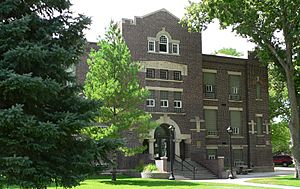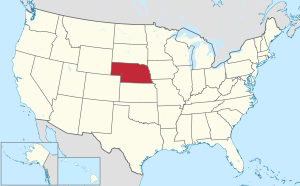Chase County, Nebraska facts for kids
Quick facts for kids
Chase County
|
|
|---|---|

Chase County courthouse in Imperial
|
|

Location within the U.S. state of Nebraska
|
|
 Nebraska's location within the U.S. |
|
| Country | |
| State | |
| Founded | February 27, 1873 (authorized) 1886 (organized) |
| Named for | Champion S. Chase |
| Seat | Imperial |
| Largest city | Imperial |
| Area | |
| • Total | 897 sq mi (2,320 km2) |
| • Land | 894 sq mi (2,320 km2) |
| • Water | 3.1 sq mi (8 km2) 0.5%% |
| Population
(2020)
|
|
| • Total | 3,893 |
| • Density | 4.3400/sq mi (1.6757/km2) |
| Time zone | UTC−7 (Mountain) |
| • Summer (DST) | UTC−6 (MDT) |
| Congressional district | 3rd |
Chase County is a county in the U.S. state of Nebraska. As of the 2020 United States Census, the population was 3,893. Its county seat is Imperial.
In the Nebraska license plate system, Chase County is represented by the prefix 72 (it had the 72nd-most vehicles registered in the state when the license plate system was established in 1922).
Contents
History
Chase County was named after Champion S. Chase, who served as mayor of Omaha for seven years and was Nebraska's first Attorney General.
Chase County was separated from Hayes County by the Nebraska legislature on February 27, 1873, although the county was not organized until 1886.
It was once said that, excluding ranch owners, their wives, and their cooks, at the time Chase County was organized it was populated entirely by cowboys. Part of the reason for such a statement may have been the fact that at one time Frenchman Creek and its main branch the Stinking Water Creek were used as watering stops for cattle drives that traveled from Texas to the Union Pacific railhead at Ogallala. These trails are known as the Western or Great Western trails.
Chase County sits in the region once referred to as the Great American Desert. However, on the broad, fertile plateau, early settlers quickly discovered that Chase County's dark sandy loam soil was excellent for farming.
The railroad came to Chase County in 1892, reaching Wauneta on January 28. It was built by a division of the Chicago, Burlington and Quincy Railroad. This line left the main line near Culbertson and terminated in Imperial.
National Register of Historic Places listings
- Imperial
- Balcony House (listed 2000)
- Chase County Court House (listed 1990)
- Wauneta
- Wauneta Roller Mills (listed 2008)
- Champion
- Champion Mill (listed 1988)
- Rural Areas
- Lovett Site (listed 1972)
- Texas Trail Stone Corral (listed 2002), on Spring Creek North of Imperial
Geography
Chase County is on the west edge of Nebraska. Its west boundary line abuts the east boundary line of the state of Colorado. According to the US Census Bureau, the county has a total area of 897 square miles (2,320 km2), of which 894 square miles (2,320 km2) is land and 3.1 square miles (8.0 km2) (0.3%) is water.
Chase County is geographically diverse. The spring-fed Frenchman Creek crosses the county from west to southeast. From Enders to Wauneta the path of the creek exposes limestone outcroppings. North of Wauneta is an area of significant loess deposits, including the typical steep-walled canyons. Rolling Sandhill formations are found in the north-central and southwestern areas of the county.
The Pierre Shale of Upper Cretaceous Age is the underlying structure of the region. At Enders Dam this formation is found at a depth of 175 feet (53 m) below the valley floor. The Ogallala Formation of Pliocene Age overlies the Pierre Shale. The Ogallala Formation is composed of fine to coarse sand, some gravel, calcareous silt, silty sands, silts and clays. Various degrees of calcareous cementation occur, resulting in lenses of varying loose unconsolidated to very firm compact materials at irregular intervals. The Ogallala beds lie almost horizontal and structural irregularities, such as faulting, have been observed in the area.
The Ogallala Formation is of vital importance to the county and the surrounding areas. The associated Ogallala Aquifer is the primary source of water for the population and livestock, and an important input into agricultural economy of the county.
Adjacent counties
- Hayes County – east
- Dundy County – south
- Yuma County, Colorado – southwest
- Phillips County, Colorado – west
- Perkins County – north
Protected areas
- Church Grove Recreation Area
- Enders Reservoir State Recreation Area
Demographics
| Historical population | |||
|---|---|---|---|
| Census | Pop. | %± | |
| 1880 | 70 | — | |
| 1890 | 4,807 | 6,767.1% | |
| 1900 | 2,559 | −46.8% | |
| 1910 | 3,613 | 41.2% | |
| 1920 | 4,939 | 36.7% | |
| 1930 | 5,484 | 11.0% | |
| 1940 | 5,310 | −3.2% | |
| 1950 | 5,176 | −2.5% | |
| 1960 | 4,317 | −16.6% | |
| 1970 | 4,129 | −4.4% | |
| 1980 | 4,758 | 15.2% | |
| 1990 | 4,381 | −7.9% | |
| 2000 | 4,068 | −7.1% | |
| 2010 | 3,966 | −2.5% | |
| 2020 | 3,893 | −1.8% | |
| US Decennial Census 1790-1960 1900-1990 1990-2000 2010 |
|||
As of the 2000 United States Census, there were 4,068 people, 1,662 households, and 1,163 families in the county. The population density was 4 people per square mile (1.5 people/km2). There were 1,927 housing units at an average density of 2 units per square mile (0.77/km2). The racial makeup of the county was 97.81% White, 0.17% Black or African American, 0.10% Native American, 0.17% Asian, 0.02% Pacific Islander, 1.47% from other races, and 0.25% from two or more races. 3.42% of the population were Hispanic or Latino of any race. 44.6% were of German, 13.0% American, 12.3% English and 7.1% Irish ancestry.
There were 1,662 households, out of which 30.60% had children under the age of 18 living with them, 62.10% were married couples living together, 5.50% had a female householder with no husband present, and 30.00% were non-families. 27.30% of all households were made up of individuals, and 13.80% had someone living alone who was 65 years of age or older. The average household size was 2.39 and the average family size was 2.91.
The county population contained 25.20% under the age of 18, 5.90% from 18 to 24, 23.90% from 25 to 44, 24.00% from 45 to 64, and 21.10% who were 65 years of age or older. The median age was 42 years. For every 100 females there were 96.60 males. For every 100 females age 18 and over, there were 94.80 males.
The median income for a household in the county was $32,351, and the median income for a family was $39,225. Males had a median income of $27,554 versus $17,602 for females. The per capita income for the county was $17,490. About 7.90% of families and 9.60% of the population were below the poverty line, including 10.50% of those under age 18 and 9.00% of those age 65 or over.
Economy
Chase County economy is based on agriculture. A third of the county's area is under irrigation; another fourth is used for dry farming. The rest is rangeland. Wheat, corn, edible beans (pintos, kidneys and great northerns), soybeans and sugar beets are the principal crops. Livestock production is equally important in the county's economy. In 2007, sales of agricultural products exceeded $125 Million, with Corn ($96 Million) and Wheat ($11 Million) being the primary crops.
Transportation
The main highway routes crossing Chase County are U.S. Route 6 which crosses east–west and Nebraska Highway 61 which crosses north–south. The county is served by the Nebraska Kansas & Colorado Railway. NKCR is an operating company of OmniTRAX. This short line operates the branch line which interchanges with the BNSF. This line enters the county near the southeastern corner passing through Wauneta and Enders, terminating at Imperial.
Major highways
Communities
City
- Imperial (county seat)
Villages
Census-designated places
Former communities
- Best
- Blanche
- Chase
- Lamar, unincorporated November 5, 2024
Notable people
Lee Edward Travis - psychiatrist and speech pathologist
See also
 In Spanish: Condado de Chase (Nebraska) para niños
In Spanish: Condado de Chase (Nebraska) para niños

